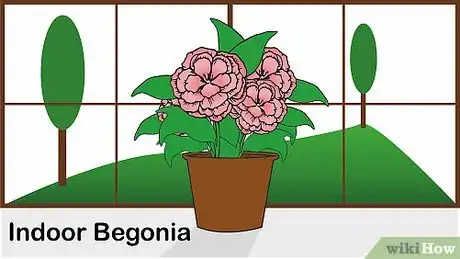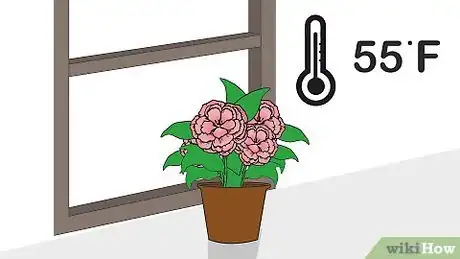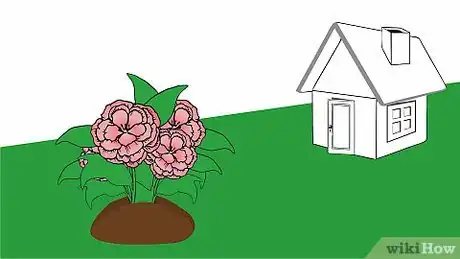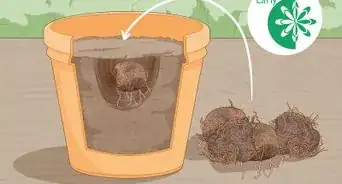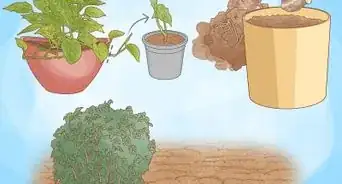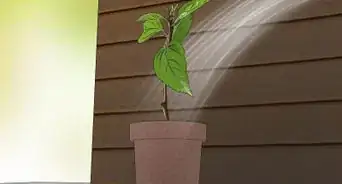This article was co-authored by Melinda Meservy. Melinda Meservy is a Plant Specialist and the Owner of Thyme and Place, a botanical boutique offering plants and gifts in Salt Lake City, Utah. Before starting her own business, Melinda worked in process and business improvement and data analytics. Melinda earned a BA in History from the University of Utah, is trained in lean and agile methodologies, and completed her Certified Professional Facilitator certification. Thyme and Place offers indoor plants and containers, a fully stocked potting bench, and tips on plants to suit your space and lifestyle.
wikiHow marks an article as reader-approved once it receives enough positive feedback. This article has 44 testimonials from our readers, earning it our reader-approved status.
This article has been viewed 1,037,098 times.
You know you've hit the flower jackpot when your plant is known for its brilliant flowers and its fancy foliage. The begonia has both of these lovely features. Begonias can be high-maintenance at times, but the end result of having a beautiful, flowering plant is well worth it.[1] In summary, the begonia is an awesome plant. Follow these steps to learn how to care for this perfect plant.
Steps
Indoor Begonias
-
1Choose an indoor type of begonia. This list of begonias that grow well indoors is extensive. It is important to remember that some types of begonias are grown for their brilliantly colored flowers, while other begonias are enjoyed for their unique and beautiful foliage. Most begonias bought at nurseries will be labeled as indoor plants or outdoor plants.
- There are two main categories of cultivated begonias based on growth habits. Also there are hybrids within these groups.
- Cane Begonias grow upwards on tall stems that resemble bamboo in appearance. The Angel Wing Begonia is a common example.
- Fibrous root Begonia species have stems that are directly attached to the crown of the plant like that of radish leaves. This group includes the Rex Begonia hybrids.
- If you are still uncertain of whether or not your plant will work well indoors, ask an employee at your local nursery.
-
2Plant indoor begonias in a good indoor potting soil. When potting your begonias, you should keep three factors in mind: the type of soil, the size of pot, and the amount of soil you use.
- When choosing your potting material, you want the soil to be relatively neutral or slightly acidic on the pH scale.
- Your pot should roughly fit the size of your plant--you want to keep root growth in mind but do not want the pot to be overly large.
- A pot that is too large can lead to using too much soil. When a pot contains too much soil, it can lead to soggy soil that could potentially ‘drown’ your plant roots and kill your begonia.
- Some people also grow begonias in wet stones or small pebbles as a top medium. You don’t have to completely bury the plant’s rhizome to do this. Just place it on top of the stones.
Advertisement -
3Place indoor begonias where they get bright light. Begonias like a lot of light so place them on windowsills that face east or west so that your plants get several hours of sunlight each day. Avoid southern windows from February through September, as they let in too much light, unless you hang thin curtains that filter the light.[2]
- Be sure to filter the light coming from eastern or western windows if these face concrete or water.
- If you choose to use fluorescent lights, you should place it 6 to 12 inches above your plant. You should keep the light on for roughly 12 hours a day, though some begonia growers leave their lights on for 14. Keep in mind that you will need to water your plant more often when you use artificial light.[3]
-
4Keep indoor begonias warm. You will want to make sure that the minimum night temperature is 55ºF (13ºC). Begonias do not handle cold well and will suffer from lower temperatures.[4]
-
5Water begonias carefully. Water your plants when the surface of the potting soil feels dry to the touch. You should water your plants more frequently when it is warm, the light is bright and the begonias are flowering heavily and putting out new growth. Water your plant until water runs out of the drainage holes.[7]
- Let the potting soil dry out slightly between watering during lower light and cooler temperatures of late fall and winter.
- If possible, use room temperature water that has been distilled. Promptly empty drained water from trays and saucers.
- Mist the foliage of Rex (foliage) type begonias twice a week or provide high humidity to avoid leaf drop. Use warm water in a misting bottle.
-
6Fertilize your begonias. You should fertilize your winter-blooming plants with a high-phosphorus, water-soluble fertilizer that contains little or no nitrogen. Do this once a month from February through September. Fertilize your plants less frequently during the late fall and winter months because your plant will not be growing as steadily during this time.
- Mix the fertilizer according to the label’s directions.
- Wait three months before fertilizing if the potting mix you used contained fertilizer.
-
7Groom the plants regularly. Your should remove dead flowers and leaves. You should also trim off broken stems to promote plant growth. Dust the leaves if it is needed.
- Remove the small flowers of Rex type begonias as they start to bloom to concentrate the plants energy on foliage. of water and spray the remaining leaves with it. It would also be a good idea to increase the air circulation around the plant to prevent further incidences.”
EXPERT TIPMaggie Moran is a Professional Gardener in Pennsylvania.Home & Garden Specialist
 Maggie Moran
Maggie Moran
Home & Garden SpecialistExpert Trick: If you notice any leaves with mildew, mix 1 tablespoon (15 mL) of baking soda with 1 quart (.95 L) of water and spray the leaves. This will get rid of mold growth! After you do this, put the plant in a sunny spot that has good air circulation, like a window or an open counter.
Outdoor Begonias
-
1Pick the right location for planting. Plant all types of begonias outside in a partly or lightly shaded location after all danger of frost has passed. Use Tuberous begonias for planters or hanging baskets. Use fibrous rooted begonia for creating beautiful flower beds.[8]
- Place begonias where they get early morning or late afternoon sun to ensure that you get the best bloom. You can also place them in a location where they get dappled sunlight all day.
- Avoid sitting begonias in containers on hot surfaces such as asphalt or concrete.
- Start tuberous begonias inside 3 months before your last frost in the spring for best blooming results. See notes on how to start them.
-
2Plant your begonias in fertile soil. Begonias like fertile that is rich in nutrients. You can create this sort of soil by adding peat moss to the area, as well as thoroughly rotted compost. You also have to make sure that your plants’ roots have good drainage or else they could rot.
- Try to avoid planting begonias in areas with strong wind, as they have weak stems that can be damaged by large gusts of wind.
- Once you’ve found a good location and prepped your soil, dig holes the size of your begonias’ containers spaced about 12 to 18 inches apart.
-
3Water outdoor begonias. You want to make sure that you water begonias so that their soil is moist by not soggy. This means letting the top inch of soil dry out before water the plants again. Soggy soil can lead to a rotting or dead begonia.[9] [10]
- Water begonias planted in containers until the water runs from the drainage holes.Dump the drained water out of any trays or saucers immediately after watering.
- Check hanging baskets of begonias frequently as they can dry out in one day. If you find that the soil is dry to the touch, water the plant.
-
4Fertilize begonias. Begonias prefer a balanced fertilizer, meaning that the fertilizer is neutral rather than acidic or basic. Work a slow release granular fertilizer into the ground where you plan to plant your begonias.
- Read and follow the label’s directions for the amount to use.
- Repeat the fertilizer application in three months by gently working it in the soil around the plants.
- Use a water-soluble fertilizer for blooming plants once a week if you do not use a granular fertilizer.
-
5Remove dead flowers and leaves frequently. Doing this will ensure that the healthy parts of the plant are free to keep growing.
-
6Cut back your begonias. Cut back bedding or fibrous begonias to 3”(7.6 cm) every 4 months in mild climates where there is no frost to renew the plants. This will ensure that they continue to grow and remain healthy.
- Bring in bedding begonias that were growing outside to grow inside for the winter. Dig them before the first frost and pot them. Cut the plants back to about 3” to start new growth. See indoor care above.
-
7Enjoy your beautiful begonias!
Expert Q&A
Did you know you can get premium answers for this article?
Unlock premium answers by supporting wikiHow
-
QuestionDo begonias like sun or shade?
 Maggie MoranMaggie Moran is a Professional Gardener in Pennsylvania.
Maggie MoranMaggie Moran is a Professional Gardener in Pennsylvania.
Home & Garden Specialist
-
QuestionHow do you cut back a begonia?
 Maggie MoranMaggie Moran is a Professional Gardener in Pennsylvania.
Maggie MoranMaggie Moran is a Professional Gardener in Pennsylvania.
Home & Garden Specialist
-
QuestionWhat is the best food for begonias?
 Maggie MoranMaggie Moran is a Professional Gardener in Pennsylvania.
Maggie MoranMaggie Moran is a Professional Gardener in Pennsylvania.
Home & Garden Specialist
Warnings
- Many begonias have fleshy, brittle stems that are easily broken. Keep them out of wind or areas where they will be bumped.⧼thumbs_response⧽
- Overwatering is the biggest cause of indoor begonia death. Do not keep pots too wet.⧼thumbs_response⧽
- Remember, not all begonias love sunlight and too much exposure can damage some of them. Follow whatever instructions you received for that specific begonia.⧼thumbs_response⧽
Things You’ll Need
- Mist bottle for Rex begonias
- Potting soil
- Blooming plant fertilizer
References
- ↑ Melinda Meservy. Plant Specialist. Expert Interview. 18 August 2020.
- ↑ http://homeguides.sfgate.com/indoor-begonia-care-64721.html
- ↑ http://homeguides.sfgate.com/indoor-begonia-care-64721.html
- ↑ Melinda Meservy. Plant Specialist. Expert Interview. 18 August 2020.
- ↑ Melinda Meservy. Plant Specialist. Expert Interview. 18 August 2020.
- ↑ Melinda Meservy. Plant Specialist. Expert Interview. 18 August 2020.
- ↑ http://homeguides.sfgate.com/indoor-begonia-care-64721.html
- ↑ http://homeguides.sfgate.com/outdoor-begonia-care-65118.html
- ↑ http://www.sunset.com/garden/flowers-plants/easy-care-begonias-00400000015643/
- ↑ http://homeguides.sfgate.com/outdoor-begonia-care-65118.html
- ↑ Melinda Meservy. Plant Specialist. Expert Interview. 18 August 2020.
- Hogan, Sean, Flora, Portland, Oregon, Timber Press, 2003, Vol.1 pg. 224-227
About This Article
To care for a begonia, figure out if your type thrives best indoors or outdoors—if you aren't sure, ask someone at your local nursery! All begonias like bright but indirect light, so find a partially shaded spot for your plant. Make sure the soil is rich, fertile, and well-draining, since begonias are susceptible to root rot. Fertilize begonias often during the growing season, and groom them regularly to remove dead flowers and leaves. If you're growing begonias outdoors, you'll need to cut them back every 4 months to keep them healthy and happy. To learn more about where to keep indoor begonias from our Horticulturist co-author, keep reading!

